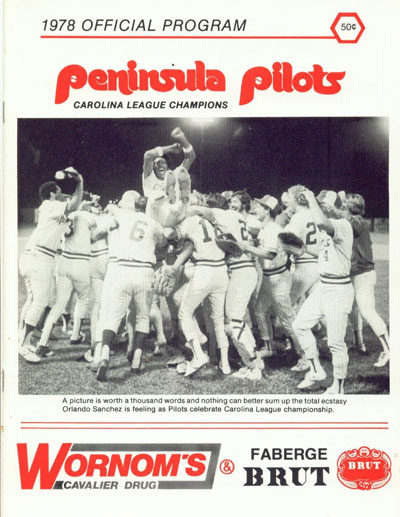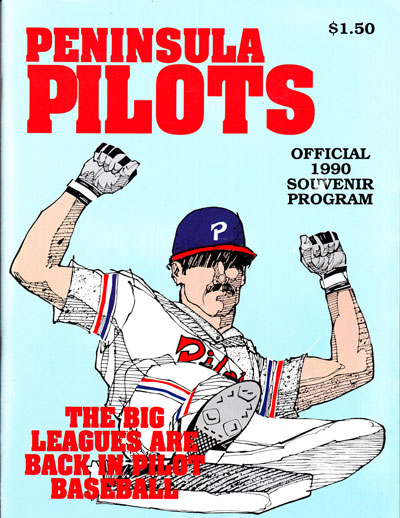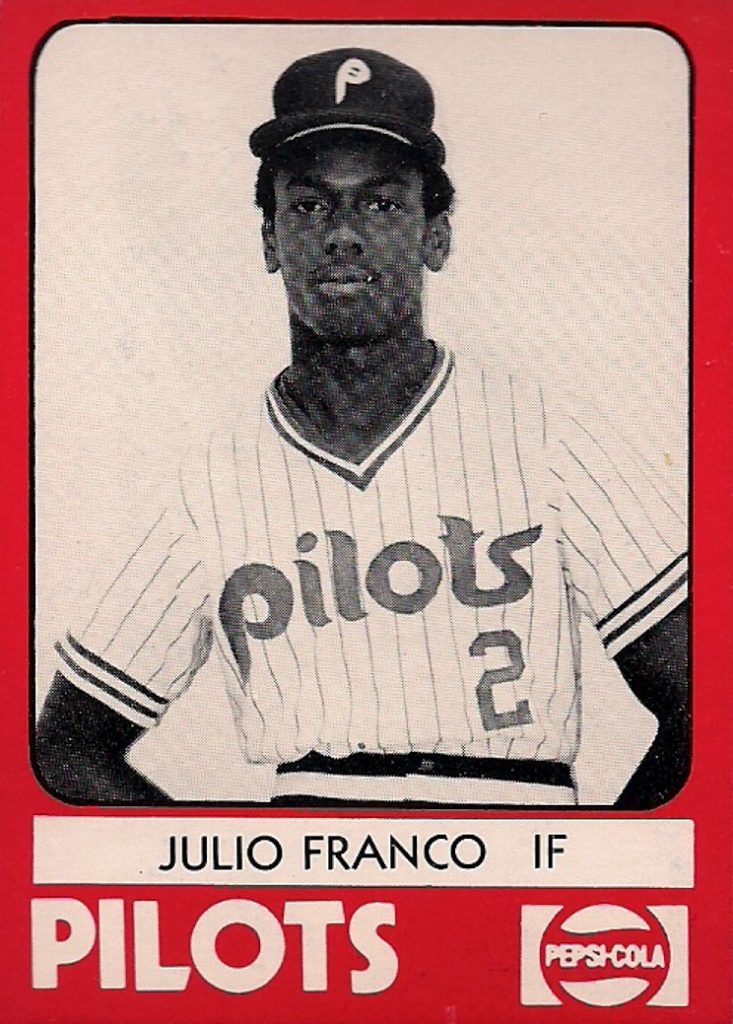Tombstone
Born: 1976
Moved: October 1992 (Wilmington Blue Rocks)
First Game: April 16, 1976 (W 7-3 vs. Salem Pirates)
Last Game: September 8, 1992 (W 5-4 vs. Lynchburg Red Sox)
Carolina League Champions: 1977, 1980 & 1992
Stadium
War Memorial Stadium
Opened: 1948
Marketing
Radio Station (1975): WVEC 1490
Ownership & Affiliations
Owners:
- 1976-1981: Philadelphia Phillies
- 1982-1984: Joe Buzas
- 1985-1988: Gil Granger
- 1989-1992: Jay Acton
Major League Affiliations:
- 1976-1985: Philadelphia Philies
- 1989: Co-op
- 1990-1992: Seattle Mariners
Background
Joe Buzas purchased the Philadelphia Phillies’ foundering double-A farm club in Reading, Pennsylvania for $1.00 in 1977. Miles Wolff entered the Durham Bulls in the Carolina League in late 1979 for an expansion fee of $2,417. Buzas flipped the Reading Phillies to Craig Stein for $1 million in 1986. By 1995, Stein pegged Reading’s value at $8 million. In 1990, two years after the release of Bull Durham helped fuel the minor league boom, Wolff sold the Bulls for a rumored $4 million.
During the 1980’s, overlapping events fueled a surge in minor league baseball valuations. The 1981 Major League Baesball strike sparked media and fan interest in alternatives, of both the minor league and Rotisserie league varieties. Wall Street traders and corporate investors development an interest, spurred in part by the merchandising bonanza of Bull Durham and the “if you build it they will come” entrepreneurial mantra of Field of Dreams. This new breed of operator knew how to push and tug the levers of municipal politics like the mom-and-pops never dreamed of, fueling a stadium construction boom.
The supply of Major League farm clubs was (and is) fixed. Minor League Baseball is a monopoly governed, at the time, by the National Association of Professional Baseball Leagues. Prices skyrocketed for profitable, well-operated clubs like Reading and Durham. They also soared for basket case clubs that struggled to maintain Major League affiliations in antiquated ballparks. The membership itself was the thing. Once you acquired one, you had a relatively portable asset with no small number of cities willing to float a bond for a gleaming new ballpark. Basket case in point: the Peninsula Pilots of the Carolina League.

Carolina League
Launch of the Pilots
The single-A Carolina League first set up shop at War Memorial Stadium on the Virginia Peninsula in 1963. Adopting the “Peninsula” moniker, the ball club fed the appetites of baseball fans in the adjacent cities of Hampton and Newport News for the next dozen summers. The club took on six different identities in a little more than a decade. The Senators, Grays, Astros, Pilots, Whips, and Pennants all came and went as Major League parent clubs kicked the affiliate back and forth.
After a summer without baseball in 1975, the Philadelphia Phillies placed their single-A farm club in Hampton in 1976, ushering in a ten-year period of stability and on-field success for baseball on the Peninsula. Under Phillies’ management, a new version of the Peninsula Pilots won Carolina League championships in 1977 and 1980.
The 1980 Pilots set a Carolina League record with a 100-40 record. They swept the expansion Durham Bulls in the Championship Series 3 games to zero. 18-year old pitcher Roy Smith posted a 17-6 record, tops on a staff where five pitchers posted ten or more wins. Bahamian outfielder Wil Culmer won the Carolina League batting crown with a .369 average and led the club in home runs with 18. 21-year old shortstop Julio Franco would go on to the greatest Major League success of any of the 1980 Pilots. He drove in 99 runs and stole 44 bases for Peninsula that summer.
In 2001, baseball historians Bill Weiss and Marshall Wright ranked the 1980 Pilots #74 on a list of the 100 greatest minor league teams of all time, compiled for MiLB.com to celebrate the 100th anniversary of the National Association.

Sold for One Dollar
In 1982, the Phillies sold the Pilots to Joe Buzas, operator of their double-A club in Reading. As with Reading, Buzas reportedly bought the Pilots for the price of that game program – one dollar. A legend in minor league circles, it is alleged that Buzas owned between 60 and 82 baseball teams at various times from 1958 until his death in 2003. Buzas was the polar opposite of the P.T. Barnum-style minor league huckster who sought headlines with outlandish promotions. Tight-fisted and hands-on, Buzas’ gift was to wring profit from a struggling ball club, even with only a few hundred fans seated in the grandstand.
“<Owning ball clubs> was his hobby. He made a lot of money from it,” Gerry Berthiaume, one of his former General Managers recalled to The Hartford Courant in 2003. “He wouldn’t spend it to market his clubs, but for the people who worked for him, he was a generous person.”
1986-1988: Peninsula White Sox & Virginia Generals
Buzas flipped the Pilots in 1985 to Williamsburg developer Gil Granger for $160,000. The Phillies departed the same year after ten years on the Peninsula. Granger signed a new, but ultimately short-lived, affiliation deal with Chicago of the American League. The club played as the Peninsula White Sox in 1986 and 1987. During Granger’s final year of ownership in 1988, he couldn’t find a Major League parent club at all. He changed the name of the team to the Virginia Generals and played as a “co-op” team, borrowing players from several different Major League organizations. That summer Baseball America called the Granger’s Generals the “worst” and “wackiest” team in professional baseball.
Nevertheless, Granger was able to sell the club in 1988. Jay Acton and Eric Margenau’s United Baseball paid $600,000, nearly quadruple what Granger paid three years earlier

1989-1992: Return of the Pilots
Acton ditched the Generals adventure and revived the Peninsula Pilots name for the 1989 season, but he was not immediately able to reclaim a Major League partner. The club endured a second straight season as a co-op team, meaning the club had to pay many of the player-related costs typically picked up by the parent organization.
“Let’s face it. We have a very bad image among farm directors,” Acton told the The Daily Press of Newport News in 1989.
The Pilots in those days often played to crowds of 300-400 fans. The team had an unusually high number of rainouts because it didn’t own a tarp. The small band of characters who ran the ballpark found ways to amuse themselves:
“Terry Armour was our beat writer from The Daily Press/Times Herald. Terry filled in as PA announcer once in a while. He was a character. One of the funniest guys I knew,” former General Manager John Tull recalled in 2011. “Sometimes Terry would break out Harry Caray doing Take Me Out to the Ballgame for the crowd. One night during the 7th inning stretch instead of Take Me Out to the Ballgame he started singing Jefferson Airplane’s White Rabbit over the PA instead. Looking back it was funny. At the time it was funny too.”
“The Beautiful Thing About This is Everybody Contributed”
In 1990, Acton signed an affiliation with the Seattle Mariners – who provided the long-awaited tarp! – giving Peninsula its first parent club since the 1987 Peninsula White Sox. The relationship with the Mariners would be rocky – literally. During the 1991 season, the Mariners pulled several top prospects from Peninsula and refused to send others over their displeasure with the quality and safety of War Memorial Stadium’s uneven playing surface and replaced them with younger, greener players. The Pilots responded by setting a Carolina League record losing streak of 22 games, a streak which they finally broke with a victory on the season’s final day.
“There is nothing like this,” the Pilots 1991 field manager Steve Smith told The Associated Press after setting the loss record. “The beautiful thing about this is everybody contributed.”
Move To Delaware
During the 1991 season, Acton announced plans to move the club to Wilmington, Delaware, where city officials agreed to build a new ballpark. War Memorial Stadium was now obsolete. It would officially be in default of National Association minimum standards set to take effect in 1994. Then in the offseason a local buyer emerged. Local developers Bob and Marilyn DeLuca offered Acton $1.68 million for the Pilots. The DeLuca’s planned to build a new 5,000-seat stadium to keep baseball on the Peninsula. The DeLuca’s operated the club through much of the winter, but the deal fell through a month before the 1992 season.
After the DeLuca sale fell through, Acton struck a new deal with former New York Mets star Bud Harrelson and Long Island investment banker Frank Boulton to sell the club to them at the conclusion of the 1992 season. Harrelson operated the club essentially on loan during the summer of 1992, while final details of the $1.6 million sale were worked out. At the conclusion of the 1992 season, Harrelson and Boulton moved the club themselves to Delaware. The former Pilots franchise plays there to this day as the Wilmington Blue Rocks.
Voices
“<The> ballpark that was in terrible shape. The bleachers were broken, the little concession stands were trashed and it looked like no one had played baseball there for a very long time. When I got there, the very first day, the GM they hired for me to work for resigned. He said he could not work there.
“I remember calling games at 3pm in the afternoon because we had no tarp. Then I would watch dozens of cars pull up at 6pm under sunny skies thinking there was a game. Not hundreds of cards but dozens, but still dozens was too many as you felt bad for the folks driving in thinking there was baseball.
“Dale Long worked for Major League Baseball and would travel the minor league park and submit reports on field conditions and the lighting. I remember thinking ‘there is no way this stadium will pass any standards test’. We always did.”
Peninsula Pilots Video
Downloads
1976 Pilots vs. Greenwood Braves Game Day Roster Sheet
1976 Peninsula Pilots vs. Greenwood Braves Game Day Roster Insert
2011 FWiL interview with former Pilots General Manager John Tull
Links
###


One Response
Per a talk given by longtime Reading Phillies GM Chuck Domino around 2010 to the Connie Mack Chapter of SABR, seller Joe Buzas surprised buying Craig Stein at the closing table for the Reading Phillies sale by demanding the sale price of the team be revised upward. As the table buzzed with concern, Buzas said, “I just need to raise it to $1,000,001 so I can say I made a $1 million profit in selling the team. I never made that much before.” IIRC, Stein pulled $1 out of his pocket and asked if the increase could be paid in cash since the cashier’s check (or wire transfer) was already written out, and Buzas accepted and then framed that dollar. Buzas owned 82 teams during his lifetime, but that was, I believe, the most profitable one for him.